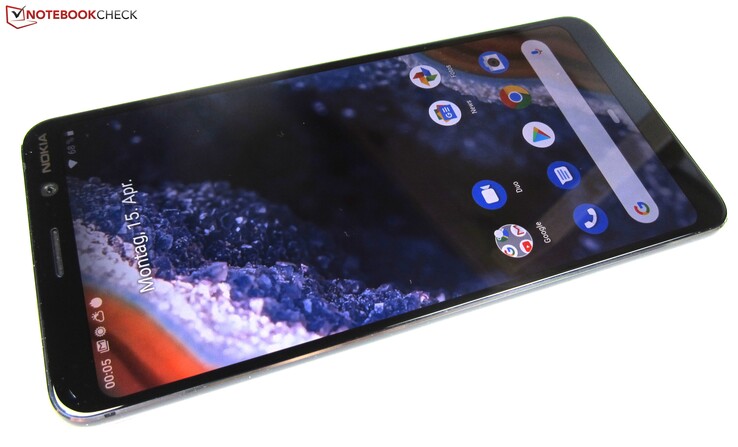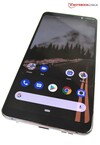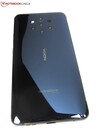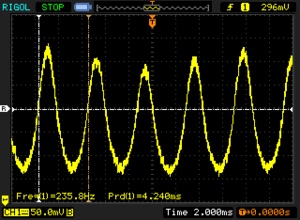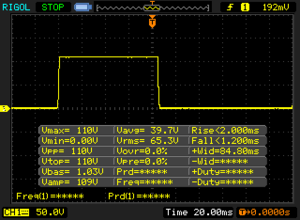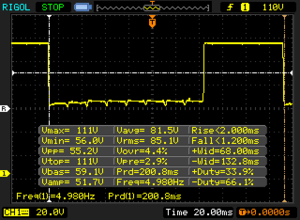Breve Análise do Smartphone Nokia 9 PureView
Os Top 10
» Os Top 10 Portáteis Multimídia
» Os Top 10 Portáteis de Jogos
» Os Top 10 Portáteis Leves para Jogos
» Os Top 10 Portáteis Acessíveis de Escritório/Empresariais
» Os Top 10 Portáteis Premium de Escritório/Empresariais
» Os Top 10 dos Portáteis Workstation
» Os Top 10 Subportáteis
» Os Top 10 Ultrabooks
» Os Top 10 Conversíveis
» Os Top 10 Tablets
» Os Top 10 Smartphones
» A melhores Telas de Portáteis Analisadas Pela Notebookcheck
» Top 10 dos portáteis abaixo dos 500 Euros da Notebookcheck
» Top 10 dos Portáteis abaixo dos 300 Euros
| Networking | |
| iperf3 transmit AX12 | |
| Huawei P30 Pro | |
| Huawei P30 Pro | |
| Apple iPhone Xs Max | |
| LG V40 ThinQ | |
| Xiaomi Mi 9 | |
| Nokia 9 PureView | |
| Sony Xperia XZ3 | |
| iperf3 receive AX12 | |
| Huawei P30 Pro | |
| Huawei P30 Pro | |
| Xiaomi Mi 9 | |
| LG V40 ThinQ | |
| Nokia 9 PureView | |
| Sony Xperia XZ3 | |
| Apple iPhone Xs Max | |
| |||||||||||||||||||||||||
iluminação: 92 %
iluminação com acumulador: 648 cd/m²
Contraste: ∞:1 (Preto: 0 cd/m²)
ΔE ColorChecker Calman: 2.3 | ∀{0.5-29.43 Ø4.78}
ΔE Greyscale Calman: 2.2 | ∀{0.09-98 Ø5}
92.5% sRGB (Calman 2D)
Gamma: 2.3
CCT: 6592 K
| Nokia 9 PureView P-OLED, 2880x1440, 6" | Apple iPhone Xs Max OLED, 2688x1242, 6.5" | Huawei P30 Pro OLED, 2340x1080, 6.5" | LG V40 ThinQ OLED, 3120x1440, 6.4" | Sony Xperia XZ3 OLED, 2880x1440, 6" | Xiaomi Mi 9 AMOLED, 2340x1080, 6.4" | |
|---|---|---|---|---|---|---|
| Screen | 16% | 8% | -6% | -74% | 24% | |
| Brightness middle (cd/m²) | 648 | 656 1% | 597 -8% | 567 -12% | 543 -16% | 593 -8% |
| Brightness (cd/m²) | 641 | 659 3% | 608 -5% | 559 -13% | 542 -15% | 587 -8% |
| Brightness Distribution (%) | 92 | 88 -4% | 89 -3% | 89 -3% | 92 0% | 94 2% |
| Black Level * (cd/m²) | ||||||
| Colorchecker dE 2000 * | 2.3 | 1.7 26% | 2.2 4% | 3.3 -43% | 6.6 -187% | 0.9 61% |
| Colorchecker dE 2000 max. * | 5.2 | 2.8 46% | 3.6 31% | 6.1 -17% | 11 -112% | 2 62% |
| Greyscale dE 2000 * | 2.2 | 1.7 23% | 1.6 27% | 1.1 50% | 4.7 -114% | 1.5 32% |
| Gamma | 2.3 96% | 1.998 110% | 2.23 99% | 2.46 89% | 1.835 120% | 2.27 97% |
| CCT | 6592 99% | 6487 100% | 6268 104% | 6495 100% | 6817 95% | 6548 99% |
* ... menor é melhor
Cintilação da tela / PWM (modulação por largura de pulso)
| Tela tremeluzindo/PWM detectado | 235.8 Hz | ||
A luz de fundo da tela pisca em 235.8 Hz (pior caso, por exemplo, utilizando PWM) . A frequência de 235.8 Hz é relativamente baixa, portanto, usuários sensíveis provavelmente notarão cintilação e sentirão fadiga ocular na configuração de brilho indicada e abaixo. [pwm_comparison] Em comparação: 53 % de todos os dispositivos testados não usam PWM para escurecer a tela. Se PWM foi detectado, uma média de 8095 (mínimo: 5 - máximo: 343500) Hz foi medida. | |||
Exibir tempos de resposta
| ↔ Tempo de resposta preto para branco | ||
|---|---|---|
| 3.2 ms ... ascensão ↗ e queda ↘ combinadas | ↗ 2 ms ascensão | |
| ↘ 1.2 ms queda | ||
| A tela mostra taxas de resposta muito rápidas em nossos testes e deve ser muito adequada para jogos em ritmo acelerado. Em comparação, todos os dispositivos testados variam de 0.1 (mínimo) a 240 (máximo) ms. » 13 % de todos os dispositivos são melhores. Isso significa que o tempo de resposta medido é melhor que a média de todos os dispositivos testados (20.2 ms). | ||
| ↔ Tempo de resposta 50% cinza a 80% cinza | ||
| 3.2 ms ... ascensão ↗ e queda ↘ combinadas | ↗ 2 ms ascensão | |
| ↘ 1.2 ms queda | ||
| A tela mostra taxas de resposta muito rápidas em nossos testes e deve ser muito adequada para jogos em ritmo acelerado. Em comparação, todos os dispositivos testados variam de 0.165 (mínimo) a 636 (máximo) ms. » 12 % de todos os dispositivos são melhores. Isso significa que o tempo de resposta medido é melhor que a média de todos os dispositivos testados (31.6 ms). | ||
| PCMark for Android | |
| Work performance score (classificar por valor) | |
| Nokia 9 PureView | |
| Huawei P30 Pro | |
| LG V40 ThinQ | |
| Sony Xperia XZ3 | |
| Xiaomi Mi 9 | |
| Média Qualcomm Snapdragon 845 (7998 - 13211, n=26) | |
| Work 2.0 performance score (classificar por valor) | |
| Nokia 9 PureView | |
| Huawei P30 Pro | |
| LG V40 ThinQ | |
| Sony Xperia XZ3 | |
| Xiaomi Mi 9 | |
| Média Qualcomm Snapdragon 845 (7360 - 9868, n=27) | |
| AnTuTu v7 - Total Score (classificar por valor) | |
| Nokia 9 PureView | |
| Apple iPhone Xs Max | |
| Huawei P30 Pro | |
| LG V40 ThinQ | |
| Sony Xperia XZ3 | |
| Xiaomi Mi 9 | |
| Média Qualcomm Snapdragon 845 (246366 - 299878, n=27) | |
| Jetstream 2 - 2.0 Total Score | |
| Média da turma Smartphone (23.8 - 387, n=149, últimos 2 anos) | |
| Huawei P30 Pro (Chrome 73) | |
| Xiaomi Mi 9 (Chrome 73) | |
| Nokia 9 PureView (Chrome 73.0.3683.90) | |
| Média Qualcomm Snapdragon 845 (22.7 - 48.9, n=4) | |
| LG V40 ThinQ (Firefox 67) | |
| Speedometer 2.0 - Result 2.0 | |
| Média da turma Smartphone (15.2 - 643, n=122, últimos 2 anos) | |
| Huawei P30 Pro (Chrome 73) | |
| Xiaomi Mi 9 (Chrome 73.0.3683.75) | |
| Média Qualcomm Snapdragon 845 (46.4 - 54.1, n=4) | |
| Nokia 9 PureView (Chrome 73.0.3683.90) | |
| LG V40 ThinQ (Chrome 71) | |
| WebXPRT 3 - Overall | |
| Média da turma Smartphone (38 - 380, n=31, últimos 2 anos) | |
| Apple iPhone Xs Max (Safari 12) | |
| Huawei P30 Pro (Chrome 73) | |
| Xiaomi Mi 9 (Chrome 73.0.3683.75) | |
| Sony Xperia XZ3 (Chrome 70) | |
| LG V40 ThinQ (Chrome 71) | |
| Média Qualcomm Snapdragon 845 (19 - 103, n=17) | |
| Nokia 9 PureView (Chrome 73.0.3683.90) | |
| Octane V2 - Total Score | |
| Média da turma Smartphone (2228 - 121337, n=197, últimos 2 anos) | |
| Apple iPhone Xs Max (Safari 12) | |
| Xiaomi Mi 9 (Chrome 73.0.3683.75) | |
| Huawei P30 Pro (Chrome 73) | |
| Sony Xperia XZ3 (Chrome 70) | |
| Nokia 9 PureView (Chrome 73.0.3683.90) | |
| LG V40 ThinQ (Chrome 71) | |
| Média Qualcomm Snapdragon 845 (3991 - 18275, n=28) | |
| Mozilla Kraken 1.1 - Total | |
| Média Qualcomm Snapdragon 845 (2154 - 11204, n=28) | |
| Nokia 9 PureView (Chrome 73.0.3683.90) | |
| LG V40 ThinQ (Chrome 71) | |
| Sony Xperia XZ3 (Chrome 70) | |
| Huawei P30 Pro (Chrome 73) | |
| Xiaomi Mi 9 (Chrome 73.0.3683.75) | |
| Média da turma Smartphone (257 - 28190, n=155, últimos 2 anos) | |
| Apple iPhone Xs Max (Safari 12) | |
* ... menor é melhor
| Nokia 9 PureView | Huawei P30 Pro | LG V40 ThinQ | Sony Xperia XZ3 | Xiaomi Mi 9 | Média 128 GB UFS 2.1 Flash | Média da turma Smartphone | |
|---|---|---|---|---|---|---|---|
| AndroBench 3-5 | 191% | 3% | 1% | 204% | 154% | 684% | |
| Sequential Read 256KB (MB/s) | 728 | 849 17% | 690 -5% | 681 -6% | 666 -9% | 761 ? 5% | 2228 ? 206% |
| Sequential Write 256KB (MB/s) | 200.3 | 250.8 25% | 203.9 2% | 196.1 -2% | 388.3 94% | 296 ? 48% | 1852 ? 825% |
| Random Read 4KB (MB/s) | 132 | 174.4 32% | 130.1 -1% | 135.7 3% | 149.4 13% | 154 ? 17% | 296 ? 124% |
| Random Write 4KB (MB/s) | 20.18 | 159.2 689% | 23.36 16% | 22.22 10% | 165.3 719% | 130.4 ? 546% | 339 ? 1580% |
| Sequential Read 256KB SDCard (MB/s) | 82.6 ? | 84.9 ? | 34.2 ? | 76 ? | |||
| Sequential Write 256KB SDCard (MB/s) | 68.2 ? | 63.1 ? | 30.4 ? | 59.6 ? |
Dead Trigger 2
PUBG Mobile
(+) A temperatura máxima no lado superior é 32.8 °C / 91 F, em comparação com a média de 35.2 °C / 95 F , variando de 21.9 a 247 °C para a classe Smartphone.
(+) A parte inferior aquece até um máximo de 33.8 °C / 93 F, em comparação com a média de 34 °C / 93 F
(+) Em uso inativo, a temperatura média para o lado superior é 27.6 °C / 82 F, em comparação com a média do dispositivo de 32.9 °C / ### class_avg_f### F.
Nokia 9 PureView análise de áudio
(+) | os alto-falantes podem tocar relativamente alto (###valor### dB)
Graves 100 - 315Hz
(-) | quase nenhum baixo - em média 25% menor que a mediana
(±) | a linearidade dos graves é média (10.4% delta para a frequência anterior)
Médios 400 - 2.000 Hz
(±) | médios mais altos - em média 5.1% maior que a mediana
(+) | médios são lineares (5.9% delta para frequência anterior)
Altos 2 - 16 kHz
(±) | máximos mais altos - em média 5.5% maior que a mediana
(+) | os máximos são lineares (5.8% delta da frequência anterior)
Geral 100 - 16.000 Hz
(±) | a linearidade do som geral é média (20.2% diferença em relação à mediana)
Comparado com a mesma classe
» 33% de todos os dispositivos testados nesta classe foram melhores, 9% semelhantes, 58% piores
» O melhor teve um delta de 11%, a média foi 35%, o pior foi 134%
Comparado com todos os dispositivos testados
» 52% de todos os dispositivos testados foram melhores, 8% semelhantes, 40% piores
» O melhor teve um delta de 4%, a média foi 24%, o pior foi 134%
Huawei P30 Pro análise de áudio
(+) | os alto-falantes podem tocar relativamente alto (###valor### dB)
Graves 100 - 315Hz
(-) | quase nenhum baixo - em média 27.2% menor que a mediana
(±) | a linearidade dos graves é média (11.9% delta para a frequência anterior)
Médios 400 - 2.000 Hz
(+) | médios equilibrados - apenas 2.5% longe da mediana
(+) | médios são lineares (2.2% delta para frequência anterior)
Altos 2 - 16 kHz
(+) | agudos equilibrados - apenas 4.4% longe da mediana
(+) | os máximos são lineares (3.7% delta da frequência anterior)
Geral 100 - 16.000 Hz
(±) | a linearidade do som geral é média (16.9% diferença em relação à mediana)
Comparado com a mesma classe
» 9% de todos os dispositivos testados nesta classe foram melhores, 7% semelhantes, 84% piores
» O melhor teve um delta de 11%, a média foi 35%, o pior foi 134%
Comparado com todos os dispositivos testados
» 29% de todos os dispositivos testados foram melhores, 8% semelhantes, 63% piores
» O melhor teve um delta de 4%, a média foi 24%, o pior foi 134%
| desligado | |
| Ocioso | |
| Carga |
|
Key:
min: | |
| Nokia 9 PureView 3320 mAh | Apple iPhone Xs Max 3174 mAh | Huawei P30 Pro 4200 mAh | LG V40 ThinQ 3300 mAh | Sony Xperia XZ3 3300 mAh | Xiaomi Mi 9 3300 mAh | Média Qualcomm Snapdragon 845 | Média da turma Smartphone | |
|---|---|---|---|---|---|---|---|---|
| Power Consumption | 23% | 11% | 24% | 30% | 27% | 10% | 1% | |
| Idle Minimum * (Watt) | 1.65 | 1 39% | 0.68 59% | 0.87 47% | 0.8 52% | 0.67 59% | 0.862 ? 48% | 0.842 ? 49% |
| Idle Average * (Watt) | 2.34 | 1.4 40% | 2.6 -11% | 1.39 41% | 1.2 49% | 1.26 46% | 1.728 ? 26% | 1.439 ? 39% |
| Idle Maximum * (Watt) | 2.43 | 1.7 30% | 2.77 -14% | 1.41 42% | 1.5 38% | 1.29 47% | 2.07 ? 15% | 1.624 ? 33% |
| Load Average * (Watt) | 5.02 | 4.6 8% | 3.74 25% | 3.96 21% | 4.8 4% | 3.71 26% | 4.87 ? 3% | 7.03 ? -40% |
| Load Maximum * (Watt) | 6.51 | 6.7 -3% | 6.82 -5% | 8.6 -32% | 6.2 5% | 9.3 -43% | 9.27 ? -42% | 11.3 ? -74% |
* ... menor é melhor
| Nokia 9 PureView 3320 mAh | Apple iPhone Xs Max 3174 mAh | Huawei P30 Pro 4200 mAh | LG V40 ThinQ 3300 mAh | Sony Xperia XZ3 3300 mAh | Xiaomi Mi 9 3300 mAh | |
|---|---|---|---|---|---|---|
| Duração da bateria | 19% | 66% | 11% | -14% | 19% | |
| Reader / Idle (h) | 20.8 | 21.8 5% | 32.8 58% | 19 -9% | 21.2 2% | 27.5 32% |
| H.264 (h) | 12.2 | 13.4 10% | 19.9 63% | 11 -10% | 7 -43% | 16.8 38% |
| WiFi v1.3 (h) | 8.1 | 12.4 53% | 14 73% | 8.5 5% | 7 -14% | 9.1 12% |
| Load (h) | 3.4 | 3.7 9% | 5.7 68% | 5.3 56% | 3.4 0% | 3.2 -6% |
Pro
Contra
O que começou como uma ideia ambiciosa acabou em decepção. A câmera quíntupla do Nokia 9 PureView certamente não é nada especial ou mesmo particularmente boa. Seu aplicativo de câmera é lento e não responde, o que piora ainda mais a impressão geral dessa câmera de smartphone.
Só podemos esperar que a HMD Global melhore ambos com uma atualização de software. É uma pena, de verdade, porque a ideia inovadora de combinar três imagens monocromáticas com duas fotos RGB tem muito potencial. As impressionantes capacidades de bokeh são a prova viva disso.
O Nokia 9 PureView não tira o máximo partido do seu inovador design de câmara quíntupla. Como resultado, definitivamente não está entre as melhores câmeras de smartphone disponíveis.
Se a qualidade da câmera é de extrema importância para você, então você terá que procurar outra coisa. O carro-chefe Mi 9 da Xiaomi vem à mente, o que, de fato, também é um pouco mais barato, para começar.
No geral, o Nokia 9 PureView ainda conseguiu deixar uma impressão decente. Sua carcaça de alumínio com certificação IP67 de alta qualidade é digna de um telefone carro-chefe e, graças ao recurso do Android One, as atualizações de segurança estão garantidas para os próximos anos. Adicionalmente, seu modem LTE Cat. 16 oferece velocidades rápidas de comunicação celular, possui um modem GPS bom e preciso, uma tela OLED muito brilhante e oferece um desempenho geral muito alto do sistema.
No entanto, a lista de desvantagens é simplesmente muito longa para um smartphone carro-chefe. Enquanto o conector para fones de 3,5 mm ausente pode ser suportado graças ao adaptador USB-C incluído, outros problemas, como o leitor de digitais com que ocasionalmente não detectou nossos dedos completamente ou a duração da bateria comparativamente curta são muito mais difíceis de engolir.
Nokia 9 PureView
- 04/18/2019 v6 (old)
Manuel Masiero




